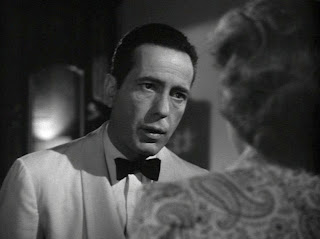The scene I chose was when Ilsa goes to Rick to get the signed letters of transit so that she and her husband Victor can leave Casablanca and make their way to Lisbon to continue his work with the Resistance.
 The first shot is of Rick walking into the room and turning on a light to find Ilsa. The table lamp gives the illusion of being the only light source, but Edeson uses a fill light to balance out the shadows created by the table lamp.
The first shot is of Rick walking into the room and turning on a light to find Ilsa. The table lamp gives the illusion of being the only light source, but Edeson uses a fill light to balance out the shadows created by the table lamp.The next shot is a full shot of Ilsa standing near the window. Light is used to create the illusion of moonlight coming in through the window which also gives an artistic element in the shadows given by the framing on the windows.
The bust shot of Ilsa uses soft shadow to create a sense of mystery
 A shallow depth of field and the primary light coming from the window side of the shot, which maintains the illusion of moonlight, create separation between the subjects and the background and gives more dimension to the subjects.
A shallow depth of field and the primary light coming from the window side of the shot, which maintains the illusion of moonlight, create separation between the subjects and the background and gives more dimension to the subjects.By shooting from the shadow side of the subjects, the lighting creates a sense of tension between Rick and Ilsa.




No comments:
Post a Comment